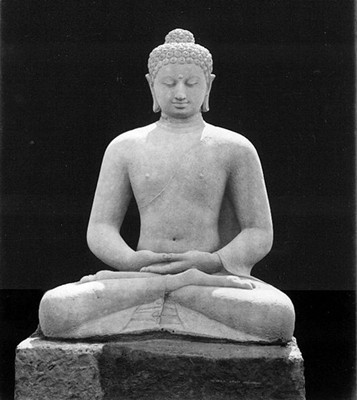In the sculpture Buddha's fingers stand in for the spokes of the wheel, and he's setting in motion the Wheel of Law to his followers, who will eventually be able to renounce the material states of illusion, suffering and individuality for the immaterial state of the highest happiness: nirvana. Here's an old Buddhist teaching:
佛陀的手指代表法輪,他為聽眾轉(zhuǎn)動(dòng)法輪,讓他們能放下虛幻的現(xiàn)實(shí),脫離苦難與自我,進(jìn)人極樂的涅槃狀態(tài)。佛陀教導(dǎo):
"It is only the fool who is deceived by the outward show of beauty; for where is the beauty when the decorations of the person are taken away, the jewels removed, the gaudy dress laid aside, the flowers and chaplets withered and dead? The wise man, seeing the vanity of all such fictitious charms, regards them as a dream, a mirage, a fantasy."
外飾粉脂。瓔珞衣服。華髮釵釧。假莊嚴(yán)身。癡人不知。橫被誑惑。于色境界。妄生欲心。若有智人。正念觀察婦人身體體性如是空無(wú)有主。猶如夢(mèng)幻。
All Buddhist art aims to detach the faithful from the physical world, even if it uses a physical image like our statue to do so.
佛教的所有藝術(shù)都教導(dǎo)人們不要眷戀虛幻的物質(zhì)世界,即使它所依賴的是佛像這種物質(zhì)實(shí)體。
來(lái)源:可可英語(yǔ) http://www.ccdyzl.cn/Article/201504/370130.shtml











